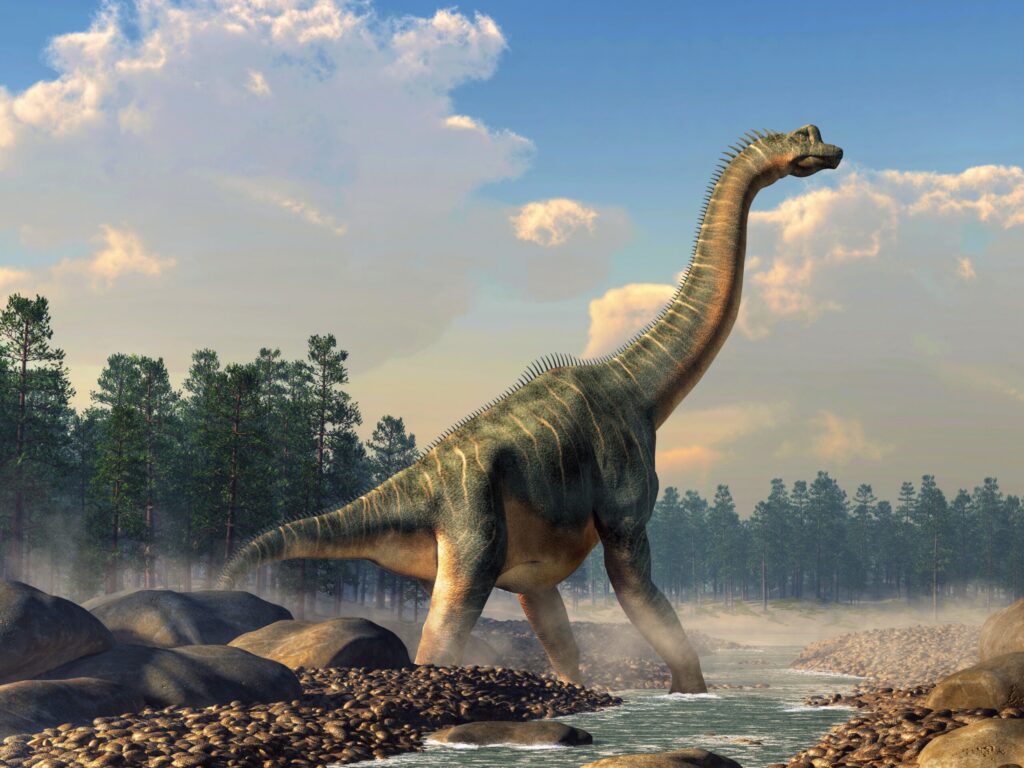The Mesozoic Era, known as the “Age of Dinosaurs,” saw the rise of some of the most colossal creatures to ever walk the Earth. Dinosaurs evolved into various forms, from tiny, agile predators to massive giants that dominated the landscapes. The largest dinosaurs, particularly the sauropods, were the largest land animals to have ever existed. These gigantic herbivores, with their long necks and tails, reached extraordinary sizes that continue to fascinate scientists and the public alike. Here are some of the largest dinosaurs ever to walk the Earth, based on fossil evidence and estimates:
1. Argentinosaurus (100-110 feet / 30-34 meters long)
Often regarded as the largest dinosaur ever, Argentinosaurus was a colossal sauropod that roamed what is now Argentina during the Late Cretaceous period, approximately 94 to 97 million years ago. Based on fossil evidence, Argentinosaurus is estimated to have been around 100 to 110 feet (30 to 34 meters) long and weighed up to 100 tons. Its immense size likely helped it reach the treetops for feeding and avoid predators.
- Key features: Argentinosaurus had a long neck and tail, typical of sauropods, and was likely a gentle giant that fed on vegetation such as conifers and ferns. Despite its enormous size, it would have moved slowly and likely lived in herds for protection.
2. Patagotitan (98 feet / 30 meters long)
Another contender for the title of the largest dinosaur is Patagotitan. Discovered in Argentina, this massive sauropod lived during the Late Cretaceous period, approximately 100 million years ago. Patagotitan measured about 98 feet (30 meters) in length and is believed to have weighed around 70 tons.
- Key features: Like Argentinosaurus, Patagotitan had a long neck and tail, and it is thought to have lived in an environment with abundant vegetation. Its massive body would have allowed it to access a wide range of plant life, and it would have been largely immune to most predators due to its sheer size.
3. Dreadnoughtus (85 feet / 26 meters long)
Dreadnoughtus was another enormous sauropod that lived in what is now Argentina during the Late Cretaceous period, around 77 million years ago. It measured about 85 feet (26 meters) long and likely weighed around 65 tons. The name “Dreadnoughtus” means “fearing nothing,” reflecting its massive size.
- Key features: Dreadnoughtus was a long-necked herbivore with an impressive body structure that allowed it to thrive in a variety of environments. Despite being smaller than Argentinosaurus and Patagotitan, its size and strength would have made it an imposing presence in its ecosystem.
4. Supersaurus (105 feet / 32 meters long)
Another enormous sauropod, Supersaurus, lived during the Late Jurassic period, around 150 million years ago. This giant dinosaur is estimated to have reached lengths of up to 105 feet (32 meters) and weighed about 35-40 tons, making it one of the longest dinosaurs known.
- Key features: Supersaurus had a long, whip-like tail and a neck that could stretch high into the treetops to feed on vegetation. It lived in what was likely a warm, tropical climate with abundant plant life, and its enormous size helped it evade predators.
5. Brachiosaurus (85 feet / 26 meters long)
One of the most well-known of the giant dinosaurs, Brachiosaurus was a massive sauropod that lived during the Jurassic period, approximately 154 to 153 million years ago. While not the largest in terms of length, Brachiosaurus stood out for its height, with estimates suggesting it could reach 85 feet (26 meters) in length and stand as tall as 40 feet (12 meters) at the shoulder, with a weight of around 50-80 tons.
- Key features: Unlike most sauropods, Brachiosaurus had relatively short tails and longer front legs, which gave it a more upright posture. This adaptation allowed it to reach higher vegetation, feeding on leaves from tall trees, which other herbivores could not access. Its massive size likely provided it with protection from predators like theropods.
6. Seismosaurus (110 feet / 33 meters long)
Known for its tremendous length, Seismosaurus was a massive sauropod that lived during the Late Jurassic period, around 150 million years ago. Its length is estimated at around 110 feet (33 meters), although some estimates suggest it could have been slightly shorter. It is thought to have weighed around 35-40 tons.
- Key features: Seismosaurus had a long neck and tail, similar to other sauropods, and it likely fed on the abundant vegetation of the Jurassic period. Its name, meaning “earth shaker,” likely refers to its immense size, which would have had a significant impact on the environment around it.
7. Titanosaurus (80-100 feet / 24-30 meters long)
Titanosaurus was a group of large sauropods that lived during the Late Cretaceous period, about 70 million years ago. Members of the Titanosaurus genus included some of the largest sauropods, with some estimates suggesting lengths of up to 80-100 feet (24-30 meters) and weights around 40-70 tons.
- Key features: Titanosaurs were distinguished by their unique body structure, which included relatively short necks, long tails, and broad bodies. They likely fed on a variety of plants and had thick, rugged skin that may have provided some protection from predators.
8. Apatosaurus (70 feet / 21 meters long)
Though not as large as some of the giants listed above, Apatosaurus was still an enormous dinosaur, with lengths of up to 70 feet (21 meters) and weights of around 20-25 tons. It lived during the Jurassic period, around 154 to 150 million years ago.
- Key features: Apatosaurus was a typical sauropod with a long neck and tail, and it likely fed on low-lying plants like ferns and cycads. Despite its size, it had a relatively slender body compared to some of the larger sauropods, and its size allowed it to dominate in its environment.
Conclusion
The largest dinosaurs to ever walk the Earth were the sauropods, a group of long-necked, plant-eating giants that reached lengths of over 100 feet and weights of up to 100 tons. These massive creatures, such as Argentinosaurus, Patagotitan, and Dreadnoughtus, are considered the largest land animals to have ever existed. Their immense size not only made them awe-inspiring but also gave them a survival advantage in the face of predators. Their legacy continues to capture the imagination of scientists and dinosaur enthusiasts, as new discoveries help piece together the remarkable story of these ancient giants.



